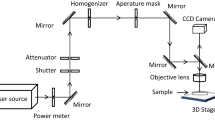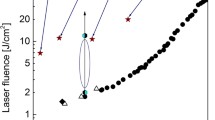3
) at wavelengths ranging from the ultraviolet to the mid-infrared, including a Nd:YAG laser operated at the fundamental, second and third harmonics, and a tunable infrared free-electron laser (wavelength range 2.5–8 μm). The threshold for ablation and the topography of the irradiated spot were characterized by scanning electron microscopy. A clear indication of two distinct excitation mechanisms was observed, namely, cracks and fractures followed by exfoliation at ultraviolet to near-infrared wavelengths, in contrast to evaporative holes and scattered droplets in the mid-infrared. Plume emission/absorption spectroscopy, plume transmission and photoacoustic beam deflection were used to characterize the ablation plasma. The composition of atoms, molecules, or particles in the ablation plumes also has a distinctive variation as a function of the wavelength. The excitation mechanisms leading to ablation appear to be defect activation at ultraviolet to near-infrared wavelengths, molecular impurity absorption and resonant vibrational absorption of the calcite at mid-infrared.
Similar content being viewed by others
Author information
Authors and Affiliations
Additional information
Received: 5 December 1996/Accepted: 6 January 1997
Rights and permissions
About this article
Cite this article
Park, H., Haglund Jr., R. Laser ablation and desorption from calcite from ultraviolet to mid-infrared wavelengths . Appl Phys A 64, 431–438 (1997). https://doi.org/10.1007/s003390050501
Issue Date:
DOI: https://doi.org/10.1007/s003390050501




